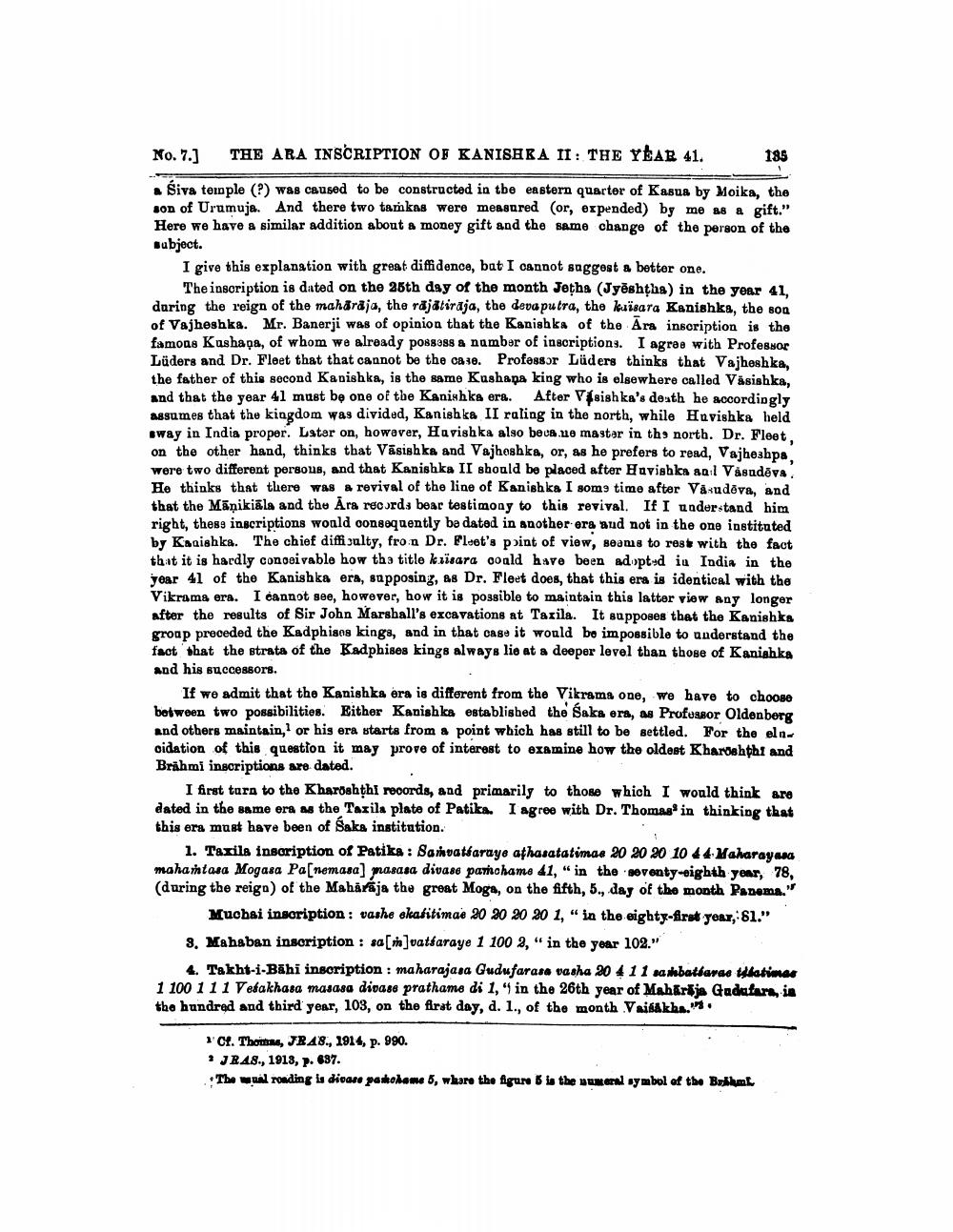________________
No. 7.]
THE ARA INSCRIPTION OF KANISHKA II: THE YEAR 41.
185
Śiva temple (?) was caused to be constructed in tbe eastern quarter of Kasua by Moika, the son of Urumuja. And there two tamkas were measured (or, expended) by me as a gift." Here we have a similar addition about a money gift and the same change of the person of the subject.
I give this explanation with great diffidence, bat I cannot suggest a better one.
The inscription is dated on the 25th day of the month Jeths (Jyēshtha) in the year 41, daring the reign of the maharaja, the räjätiraja, the deva putra, the kësara Kanishka, the son of Vajheshka. Mr. Banerji was of opinion that the Kanishka of the Ara inscription is the famous Kushapa, of whom we already po8838s & number of inscriptions. I agree with Professor Lüders and Dr. Fleet that that cannot be the case. Professor Lüders thinks that Vajheshka, the father of this second Kanishka, is the same Kushapa king who is elsewhere called Väsishka, and that the year 41 must be one of the Kanishka era. After Visishka's death he accordingly assumes that the kingdom was divided, Kanishka II raling in the north, while Havishka held way in India propor Later on, however, Havishka also bevano master in ths north. Dr. Floet. on the other hand, thinks that Vāsishka and Vajheshka, or, as he prefers to read, Vajheshpa were two different persons, and that Kanishka II should be placed after Havishka an l Vásudova He thinks that there was a revival of the line of Kanishka I some time after Vå udova, and that the Manikiāla and the Ara records bear testimony to this revival. If I understand him right, these inscriptions would consequently be dated in another ora and not in the one instituted by Ksaishka. The chief diffi sulty, fro n Dr. Fleet's point of view, seams to rest with the fact that it is hardly conceivable how tha title kužsara could have been adoptud ia India in the year 41 of the Kanishka era, supposing, as Dr. Fleut does, that this era is identical with the Vikrama era. I cannot see, however, how it is possible to maintain this latter view any longer after the results of Sir John Marshall's excavations at Tazila. It supposes that the Kanishka groap preceded the Kadphises kings, and in that case it would be impossible to anderstand the fact What the strata of the Kadphises kings always lie at a deeper level than those of Kanishka and his successors.
If we admit that the Kanishka era is different from the Vikrams one, we have to choose between two possibilities. Either Kanishka established the Saks era, as Profuasor Oldenberg and others maintain, or his era starts from a point which has still to be settled. For the ele oidation of this question it may prove of interest to examine how the oldest Kharoshthi and Brühmi inscriptions are dated.
I first turn to the Kharoshthi records, and primarily to those which I would think are dated in the same era as the Taxila plate of Patika. I agree with Dr. Thomas in thinking that this era must have been of Saka institution.
1. Taxila inscription of Patika: Barvatéaraye athasatatimaa 20 20 20 10 44 Maharayana mahartasa Mogasa Pa[nemasa masasa divase panchama 41, " in the seventy-eighth year, 78, (during the reigo) of the Maharaja the great Moga, on the fifth, 5., day of the month Padema."
Mucbai inscription : vashe skafitimae 20 20 20 20 1, "in the eighty-first year, 81." 8. Mahaban inscription : sa[min]vatsaraye 1 100 2," in the year 102."
Takht-i.Bahi inscription : maharajasa Gudufarasa va sha 20 4 11 sabatlaras the times 1 100 1 11 Vesakhasa masasa dipaso prathame di 1,4 in the 26th year of Mahirkja Gadafari, ia the hundred and third year, 103, on the first day, d. 1., of the month Vaisakhs.
Ct. Thomas, JRA8., 1914, p. 990. ? JR48., 1913, p. 687. The Waal ronding is divane paskolene 5, whare the figure B is the wateral symbol of the Balm




